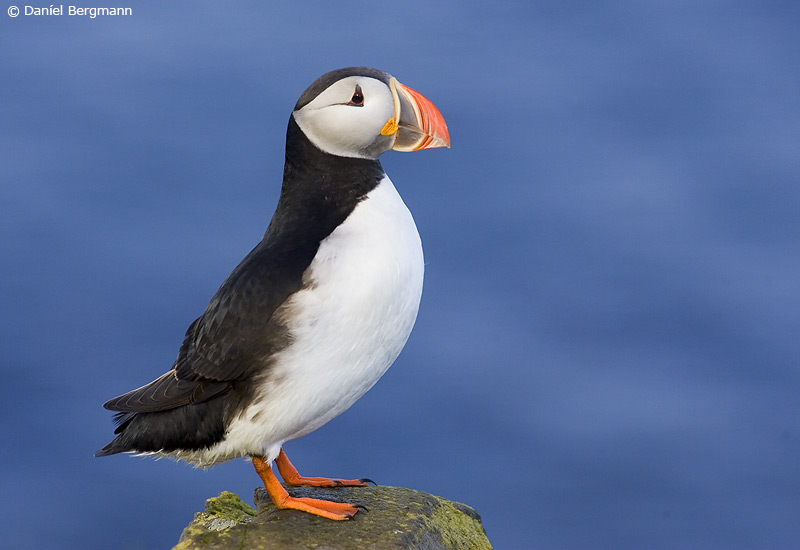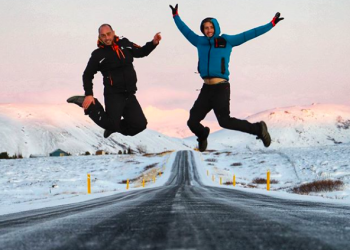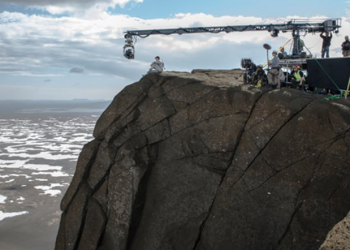Iceland is home to one of the world’s largest colonies of puffins
Over half of the world´s population of the Atlantic Puffin breeds in Iceland, somewhere between 3 – 4 million pairs each year. The total population of puffins in Iceland is estimated to be between 8 and 10 million birds. The Atlantic Puffin is one of the four species of puffins and the one most commonly found in Iceland. Icelandic word for puffin is “lundi”.
Puffins on Latrabjarg, Hornbjarg, Hornstrandir, Haelavikurbjarg, Breidafjord and Lundey
There are a number of places in Iceland where you can see the Atlantic Puffin. Látrabjarg Cliffs (Latrabjarg)
in the Vestfirðir (Westfjords), the westernmost point in Europe, is one of the three largest bird cliffs in Iceland. The other two large bird cliffs are Hornbjarg and the Nature Reserve Park of Hornstrandir, both in the north-west of Iceland. Hornstrandir is an ideal place to combine hiking and bird watching. Other puffin areas are the Vestmannaeyjar, (Westman Islands), Breiðafjörður (Breidafjord) and Lundey – Puffin Island, just 3 minutes’ sailing from Reykjavik, which has a puffin colony of around 20 000 birds.
The puffins in Hornbjarg and Hælavíkurbjarg (Haelavikurbjarg) are more trusting towards people than in other places, due to the fact that these areas do not harvest puffins. No puffins or birds are caught in Hornstrandir Natural Reserve Park. We humans are only visitors in their backyard. Many puffins in that area are so tame that we can sometimes crawl slowly towards them and even gently touch them, without scaring them away.
Puffins have also started making their homes on the second newest island on our planet, Surtsey, which erupted from the ocean off the south coast of Iceland as a volcano in November 1963. However, only scientists are allowed to land on Surtsey, to be able to observe the ecological processes unfold, undisturbed by human interference.
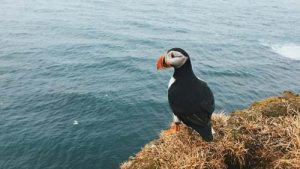
Puffins on the Westman Islands
On the Westman Islands, which hold about half of all Icelandic puffins, the puffins are both harvested and rescued. Puffins have been a vital source of food through the centuries for Icelanders in the islands. However, they are harvested sustainably. Icelanders also rescue puffins when in August millions of new-born puffins leave their burrows in the cliffs of Heimaey – the main island in the Westman Islands. Puffins leave at night using the moon to navigate, but the streetlights of Heimaey seem to throw some of the young birds off their flight paths. When that happens, it’s time for the children of Heimaey to launch the Puffin Patrol – a search and rescue operation for the befuddled birds, which, instead of flying out to sea, fly into town where they crash-land in the streets. The children of Heimaey have been rescuing young puffling chicks (“pysja” in Icelandic) for generations. In fact, at the end of summer, releasing the puffins by their hundreds to the safety of the sea has become a local tradition.
The South Iceland Natural History Institute has done extensive research into the puffins’ habitats and migratory behaviour. Air photographing and counting of the puffins’ nesting burrows has enabled ornithologists to assess that the Westman Islands habitat contains 1/5 of the world´s total number of puffins, confirming that the Westman Islands in Iceland are the largest single puffin colony in the world.
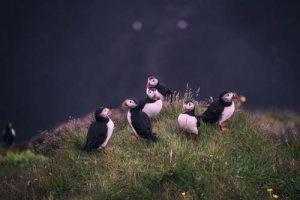
Puffin characteristics
Puffins spend most of their lives on the water, coming ashore only to breed and raise their single puffling (chick) each year. Along with the other alcids (auks), puffins swim well underwater using their flapping wings to propel them under the surface and their webbed feet to manoeuvre. Their bodies, similar in shape to the flightless penguins, are wonderful for diving and swimming but clumsy in the air. Puffins can dive to depths of about 60 metres. Taking off from land, a puffin may jump from a cliff to get enough lift to fly. From the water, a puffin flaps furiously into the wind to get airborne, similar to how airplanes head into the wind during take-off. Though hardly graceful, they are surprisingly swift flyers, able to reach a speed of 88 km an hour by flapping their wings 400 times per minute.
There are many fabulous pictures of puffins with their bills full of dangling fish; often all neatly lined up. How can a puffin hold one fish while catching another? The answer lies in the fact that they use their tongues to hold the fish securely against spines in the roof of their mouths, while leaving their beaks free to open and catch more fish. Because of their specially adapted beak, a hungry puffin’s mouth is capable of holding up to 60 fish (albeit small ones) at a time.

